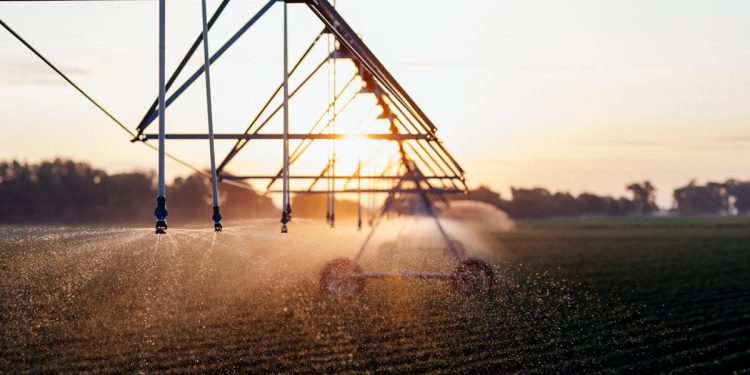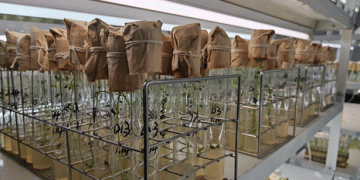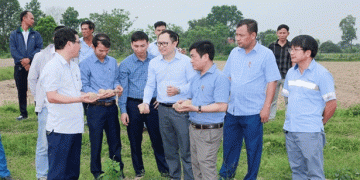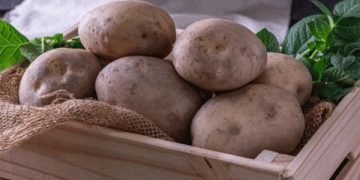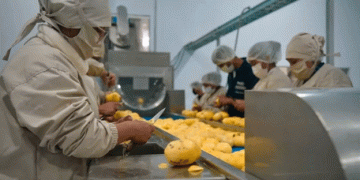#SprinklerIrrigation #Potatoes #CropProduction
The use of sprinkler irrigation systems has revolutionized farming practices by providing an effective and efficient way to water crops. When it comes to potato farming, sprinkler irrigation has proven to be a game-changer, as it helps optimize production, quality, and overall yields. In this article, we explore the benefits of sprinkler irrigation for potato farming and how it has transformed the industry.
Development:
Potatoes are among the most widely consumed crops globally, and their production is critical to ensuring food security. Over the years, potato farmers have employed various techniques to improve crop production, including the use of fertilizers, pesticides, and advanced planting practices. However, irrigation remains a significant challenge, especially in areas with limited rainfall or arid climates.
Sprinkler irrigation is a water-saving technology that uses high-pressure water to distribute water evenly over crops. The system works by spraying water onto the crop, mimicking natural rainfall. This process provides the plants with the necessary moisture to grow and thrive while minimizing water wastage. Unlike traditional irrigation methods, sprinkler irrigation systems can cover a large area, making them ideal for large-scale farming.
When it comes to potato farming, sprinkler irrigation systems have several benefits. First, they provide optimal soil moisture levels, which are crucial for tuber development. With sprinkler irrigation, farmers can control the amount of water their crops receive, ensuring that the soil remains moist but not waterlogged. Additionally, the system ensures that the water reaches the roots of the plants, providing essential nutrients and minerals required for growth.
Second, sprinkler irrigation systems are highly efficient, reducing water wastage significantly. Traditional irrigation methods such as flood irrigation result in significant water losses due to runoff and evaporation. On the other hand, sprinkler irrigation systems minimize water losses by delivering water directly to the crops. This translates to cost savings for farmers who would otherwise spend significant amounts of money on water bills.
Third, sprinkler irrigation systems promote plant health and disease resistance. By delivering water directly to the crops, the system helps prevent soil-borne diseases that thrive in wet environments. Additionally, the system enables farmers to apply pesticides and fertilizers more efficiently, resulting in healthier crops and increased yields.
Consequences of development:
The adoption of sprinkler irrigation systems in potato farming has several consequences, both positive and negative. On the positive side, the system has helped improve crop production, quality, and yields, leading to increased profits for farmers. Additionally, sprinkler irrigation has helped reduce water wastage, leading to improved water conservation and reduced environmental degradation.
However, the adoption of sprinkler irrigation systems also has some negative consequences. For instance, the initial cost of installing the system can be high, making it unaffordable for some small-scale farmers. Additionally, the system requires a reliable source of water and electricity to operate, which may not be available in some regions. Finally, the system requires regular maintenance and monitoring, which can be time-consuming and costly for farmers.
In conclusion, sprinkler irrigation is a promising solution for potato farming, and its adoption has transformed the industry. The system provides optimal soil moisture levels, reduces water wastage, and promotes plant health and disease resistance. While the adoption of sprinkler irrigation systems has some negative consequences, the benefits outweigh the challenges. As potato farming continues to evolve, the use of sprinkler irrigation systems is likely to become more widespread, leading to improved production, quality, and overall yields.
Consequences of Development:
The adoption of sprinkler irrigation systems for potato crops has the potential to significantly improve crop yields and address the challenges faced by potato farmers. However, there are also potential consequences of this development.
One potential consequence is the cost of installing and maintaining sprinkler irrigation systems. These systems can be expensive to install, particularly for small-scale farmers. In addition, they require regular maintenance to ensure optimal performance, which can also be costly.
Another potential consequence is the impact of sprinkler irrigation on soil quality. Sprinkler irrigation systems can result in soil compaction, which can impact soil structure and reduce soil fertility over time. This can lead to reduced crop yields and increased costs for farmers.
To minimize these potential consequences, it is essential to ensure that sprinkler irrigation systems are designed and installed correctly. This includes proper planning and installation of the irrigation system, regular maintenance, and monitoring of soil quality.
In conclusion, the adoption of sprinkler irrigation systems for potato crops has the potential to significantly improve crop yields and address the challenges faced by potato farmers. These systems provide a consistent supply of water and nutrients to crops and can help to address water scarcity issues. However, the adoption of sprinkler irrigation
